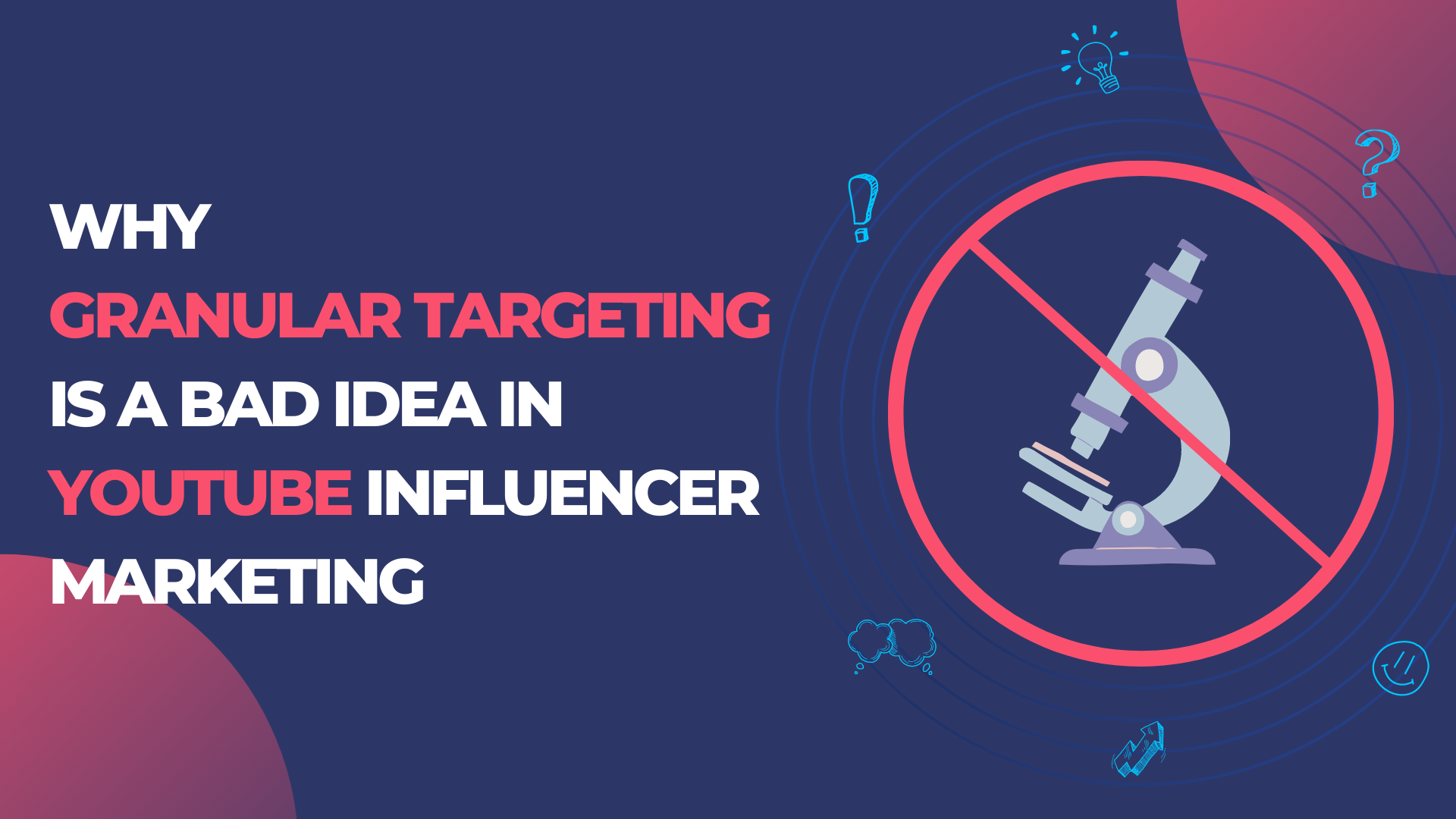YouTube sponsorships are a great way for brands to reach their target audience in a highly-engaging and authentic way. However, while it may seem like a good idea to narrow your targeting to a strictly defined age range, gender, location, and even extremely detailed channel topics, this will hurt the effectiveness of your sponsorships in the long run.
But why should you avoid overly granular targeting in creator marketing? Here are the three biggest reasons why granular targeting is usually a bad idea for influencer marketing on YouTube.
Reason 1: Granular targeting is usually based on flawed assumptions
Let’s start with a practical example to understand why granular targeting is a bad idea in influencer marketing. We use a gaming example, but similar logic applies to other industries, e.g. lifestyle and travel.
Sam is a game advertiser that wants to promote her new action-adventure game that was recently released on mobile, PC, and consoles.
Sam’s assumption is that her core players will be in the following target audience:
- Male
- Age 25-45
- Living in the US, UK, Canada, and Australia (because they’ll mostly be English speakers)
- Interested in action-adventure games.
Sam wants to be as granular as possible to avoid wasting marketing budget and reach the ideal players for her game. Based on the above parameters, she decides to only hire YouTube creators who fit ALL of the following criteria:
- They have a channel dedicated to adventure games.
- Majority of their viewers (>50%) are males aged 25-45.
- They have 60% or more of their audience from the US, UK, Canada, and Australia.
To be fair, this can be a great starting point. While Sam does get off to a great start for the first month or two, she soon discovers a few things:
- The number of creators, especially bigger ones, that fit her criteria is limited.
- Initial performance of the campaigns was great, but she quickly ran out of new creators.
- She realizes her players are not solely in her core demographic: the game is also played by women, people outside the age range, and in countries where English is not the native language – even if the game is in English.
- However, the creators she hired had very little reach with these people so she missed out on a lot of potential players.
- As she digs into the players further, Sam discovers that, in addition to games in her genre, her potential players also play other games such as FPS, action-RPGs, etc.
- If she had promoted her game also on channels covering other types of games, she could have reached her core audience much better.
After a couple of months, Sam’s granular targeting criteria cause her to run out of potential creators, so she starts to cut creator marketing efforts. She also starts seeing lower performance in organic traffic, and the game’s performance gradually diminishes, causing her to fail to reach her player targets.
By sticking to very granular targeting, Sam set her creator strategy up for failure from the beginning.
- She failed to get sufficient reach and players and saturated the available creator pool quickly. A broader creator pool would have allowed her to avoid saturation and get more reach and downloads.
- She could have gotten more players from outside of her core demographic, but because she did not want to pay for them at all, she missed out on them entirely. With the correct pricing, she could have reached them with a positive return on investment.
- She failed to understand the interests of her core audience. She could have reached them much better if she had hired a broader pool of creators.
So, what can we learn from Sam’s story?
Reason 2: Highly granular creator marketing won’t scale
For most marketers the goal of any successful marketing channel should be to get good results, at a meaningful scale, and to keep increasing activities as you can while still hitting KPIs.
While highly granular targeting can work at first, it will fail to scale and produce results consistently. This is why the vast majority of advertisers benefit most from using broader targeting when working with YouTube creators.
While there are for example a massive amount of gaming creators on YouTube, you will eventually run into supply issues if you start restricting creator selection with a combination of age, gender, channel topic, and geography restrictions.
You will also need to spend an insane amount of time looking for and reaching out to creators if you set very strict targeting criteria.
You also need to take into account that the content people in different demographics watch is far more diverse on YouTube than e.g. on linear television. If you limit your sponsorships with very granular targeting, you miss out on a significant portion of your potential audience.

This has several implications for advertisers. I’ll use gaming here as a practical example, but similar logic applies to other content categories such as lifestyle or travel as well.
People of all ages and countries watch different types of gaming content.
- You can reach many more potential players with broader targeting.
- Demographic targeting should guide pricing, not exclusions. You can pay more for your core audience, but don’t leave others out entirely.
- The country where a creator is located doesn’t matter much, it’s more important that a creator has viewers from the markets you care about.
People are interested in more than one genre.
- If people watch videos about specific game genres, it doesn’t mean they aren’t interested in others. For example, people who watch FPS videos are often interested in action-RPGs as well.
- By extension, a creator whose channel topic is about another genre, can also reach the audiences you care about the most.
- A similar example from the travel industry: if people watch domestic travel content, it does not mean they wouldn’t be interested in international travel in most cases.
Granular targeting restricts reach far too much.
- It’s better to use broader targeting, and use the more detailed audience information for price adjustments.
- Just because some specific audience segment has the best ROI for you, it doesn’t mean others can’t have good ROI too, you just need to price them right.
Granular targeting also restricts the creator pool.
- Don’t set high percentage thresholds for a creator’s audience. It will unnecessarily limit the amount of creators.
- For example, you shouldn’t only hire creators with >50% of their audience in specific countries. Creators with 10-20% in those markets can work equally well, you just have to adjust the pricing accordingly.
- Most advertisers perform best by hiring creators covering all gaming topics instead of specific sub-genres. They just need to have a meaningful share of their views coming from the advertiser’s target demographics.
But how do you make this broader targeting work cost-effectively? This is where dynamic pricing comes into play.
Reason 3: Dynamic pricing produces better results than granular targeting
Outside of a few special cases we’ll discuss later, you should aim to make your creator marketing more repeatable and work with broader audiences. Dynamic pricing makes this feasible.
Dynamic pricing means that you pay different amounts for different audiences, based on their value to you. Just like you would bid different amounts for different keywords on Google Ads based on their value to you, you can also offer creators different pricing based on the different audience segments they reach.
With creators, this means that you will not exclude creators who do not fit your strict ideal audience criteria. Instead, you pay them more for the amount of your core audience they can reach, and offer them a lower price for the viewers that are of lower potential value to you.
This has several benefits:
- You can reach more potential customers while maintaining a good return on investment.
- You do not limit your creator pool unnecessarily, which prevents you from running out of inventory and needing to stop campaigns.
- You can get more creators to accept deals, because you can offer them a better deal.
Here are a few examples of how this can work in practice:
- You pay for views from different countries differently, based on e.g. the lifetime value of users from each country.
- You offer higher prices for creators making videos in your specific genre, and offer creators making videos in other genres a lower price.
- You negotiate special collaborations with big creators who make videos reaching a bit part of your core audience.
All of this can sound quite complicated and time consuming. If you try to do all of it manually, it can certainly take a lot of time. This is why Matchmade has automated the creator pricing process.
We automatically customize the price offered to each creator based on the goals of the advertiser and fed by insights from millions of YouTube channels. This allows advertisers to hire a broad range of creators every month, enabling them to gradually scale their efforts and maintain a solid return on investment. It also keeps the price per creator efficient for the advertiser and attractive to the creator.
Granular targeting can make sense in a couple of situations
To be fair, there are some situations where granular targeting can work. The first one is if you have a niche product with a small number of potential buyers.
For example, if your product is a luxury car with a very high price tag, it’s probably best to stick to a few specialized car channels with broad reach, because the logistics of organizing a test drive are extensive, and your potential pool of buyers is going to be very limited.
There also aren’t that many of these channels around, so even if you wanted to work with more of them, you might not be able to because you’d run out of inventory fast.
The second case is if you are not looking to scale. If you are running a one-time campaign with limited budget, and are not looking to scale your creator marketing efforts, and run more frequent campaigns, it can be a perfectly valid idea to stick to narrower audience segments and work with just a few creators.
In conclusion
Outside of a few special cases, overly restricting your targeting when working with YouTube creators is usually a bad idea, because it prevents you from scaling and will cause creator supply issues over time.
Hiring a broader range of creators and correctly utilizing dynamic pricing is a far better approach for most advertisers. If you want to make your creator marketing efforts more repeatable while taking advantage of dynamic pricing in an automated manner, get in touch, we’d love to help.




